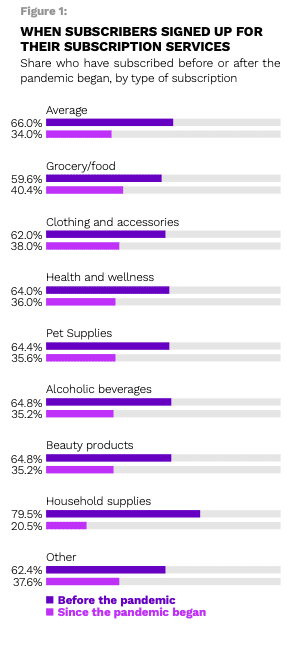Deep Dive: How Box Subscriptions Can Lean On Convenience, Smooth Payments To Keep Customers Engaged

Subscription boxes offering monthly deliveries of goods to consumers’ doorsteps were on the rise even before uptake increased after the spring of 2020. These membership boxes provide niche products tailored to individual preferences in a wide range of prices. Subscriptions had risen 17 percent annually for five straight years until 2020, with the pandemic accelerating that growth to new heights. More than half of online shoppers use subscription box services. Nearly all of them subscribing to more than one, with consumers ages 18 to 24 making up the highest number of active subscribers. Twenty-seven percent of global consumers said they plan to spend more on subscriptions this year.
The U.S. leads in adoption of subscription services, with 69 percent of consumers subscribing to multiple services, followed by Canada and Germany at 50 percent and 49 percent, respectively. Eighty-two percent of retailers in the U.K. also reported that subscription services became more popular over the past year as consumers sought safe and convenient ways to get their essentials. Entertainment subscriptions led the list, providing at-home diversion for consumers hunkering down, while meal subscription boxes became the second-most subscribed service for U.K. consumers seeking new culinary experiences as they shied away from risking exposure at restaurants.
Subscriptions inherently tend to enhance customer retention, with consumers gaining more value from a service the longer they subscribe, but monthly boxes must still work to reduce churn and subscription fatigue to maintain revenues. This month’s Deep Dive examines the strategies that companies can take to keep subscribers to these services coming back for more.
Retention Challenges
Subscriptions for eCommerce can help brands increase customer retention rates because the longer patrons subscribe, the more time and money they save, and reduce the stress of having to seek these items otherwise. Lowering customer churn is a key benefit of the subscription business model. One study found that even as little as a 5 percent increase in customer retention results in more than a 25 percent boost in revenue.
Churn is one of the biggest challenges facing eCommerce subscription companies because similarly, a small number of shoppers who cancel their subscriptions can have a significant impact on a company’s bottom line. Almost 40 percent of subscribers ditch their services in less than 90 days, while more than half quit within six months. This means that retaining customers is often a constant concern for subscription businesses. This problem is even more pronounced for subscription box businesses. One report found they face higher churn rates, even though they encourage customers to spend more on average each time they place an order.
Despite these hurdles, consumer demand for new and unique subscription experiences remains strong. PYMNTS’ 2021 Subscription Commerce Conversion Index concluded that the events of the past year have changed the nation’s subscription commerce space, especially when it comes to consumers’ desires. Subscribers say they expect their providers to test new subscription plans to determine whether the proposed offerings fit their needs and expectations. Consumers want fast, seamless subscription onboarding experiences, more choices in their plan offerings and other features such as free trials, pause functions and test options.
Many providers are working quickly to roll out free trials and other features consumers crave, but they must continue to examine how to ensure seamless service and payment options as they do. Striking the right balance between engaging, cutting-edge features and smooth payment methods could make the difference between keeping customers signed up for the long haul or seeing them drop out.

